1980 Ford Mustang Carburetor Information
The FORD code for a 1980 carburetor built for a Mustang is a E0ZE. Ford does not list any Motocraft 2150 carburetors with this number. However, they do list numbers for the carburetors listed in the table below.
| 5200 & 6500 CARBURETOR IDENTIFICATION |
DRY
FLOAT
LEVEL |
WET
FLOAT
LEVEL |
PUMP
SETTING
HOLE # |
CHOKE
PLATE
PULLDOWN |
FAST IDLE CAM LINKAGE CLEARANCE |
FAST IDLE RPM |
DECHOKE |
CHOKE SETTING |
| E0ZE-AAA |
0.460 |
|
3 |
0.276 |
0.157 |
|
0.236 |
– |
| E0ZE-ACA |
0.460 |
|
2 |
0.276 |
0.157 |
|
0.236 |
– |
| EOZE-AFC |
0.460 |
|
– |
0.236 |
0.118 |
|
0.393 |
– |
| EOZA/SC |
0.460 |
|
– |
0.236 |
0.118 |
|
0.393 |
– |
|
|
|
|
|
|
|
|
|
|
|
|
|
|
|
|
|
|
| Model 7200VV (variable venturi) |
FLOAT
LEVEL |
FLOAT
DROP |
FAST
IDLE CAM
SETTING
|
COLD
ENRICHMENT
METRING ROD |
VENTURI VALVE LIMITER |
CONTROL VACUUM IN H2O |
CHOKE GAP SETTING
– NOTCHES |
|
| All Models |
1 3/64 |
1 15/32 |
1 Rich
3rd step |
0.125 |
opening gap 0.99 – 1.01
closing gap 0.39 – 0.41 |
adjust bypass screw to 8″ Hg on vacuum gauge while car is in drive, idling at 500 rpm. Then adjust venturi valve diaphram to 6 in Hg. Then set curb to idle specification. |
See decal under hood |
|
|
|
|
|
|
|
|
|
|
|
|
|
|
|
|
|
|
|
| MODEL 2700VV (variable venturi) |
FLOAT
LEVEL |
FLOAT
DROP |
FAST
IDLE CAM
SETTING |
COLD
ENRICHMENT
METRING ROD |
VENTURI VALVE LIMITER |
CONTROL VACUUM IN H2O |
CHOKE GAP SETTING |
CONTROL VACUUM
REGULATOR
SETTING |
| All Models |
1 3/64 |
1 15/32 |
1 Rich
4th step |
0.125 |
opening gap 0.99 – 1.01
closing gap 0.39 – 0.41 |
adjust bypass screw to 8″ Hg on vacuum gauge while car is in drive, idling at 500 rpm. Then adjust venturi valve diaphram to 6 in Hg. Then set curb to idle specification. |
Refer to under hood decal |
0.075 |
|
|
|
|
|
|
|
|
|
|
|
|
|
|
|
|
|
|
| HOLLEY 1946 CARBURETOR SPECS |
FLOAT
LEVEL |
|
|
CHOKE
PULLDOWN |
FAST IDLE CAM |
ACCELERATOR PUMP STROKE SLOT |
DECHOKE |
|
| E0ZE – ED |
0.069 |
|
|
0.110 |
0.070 |
NUMBER 2 |
0.150 |
|
| E0ZE – DA |
0.068 |
|
|
0.110 |
0.070 |
NUMBER 2 |
0.150 |
|
|
|
|
|
|
|
|
|
|
|
|
|
|
|
|
|
|
|
Efficient carburetion depends greatly on careful cleaning and inspection during overhaul since dirt, gum, water or varnish in or on the carburetor parts are often responsible for poor performance.
No Subscription? You’re missing out
Get immediate ad-free access to all our premium content.
Get Started



